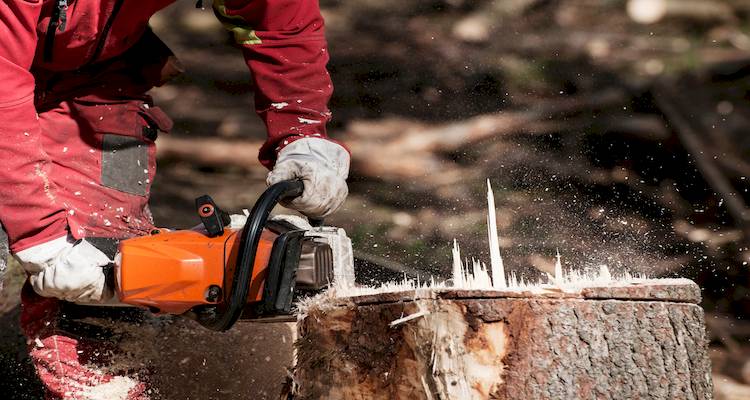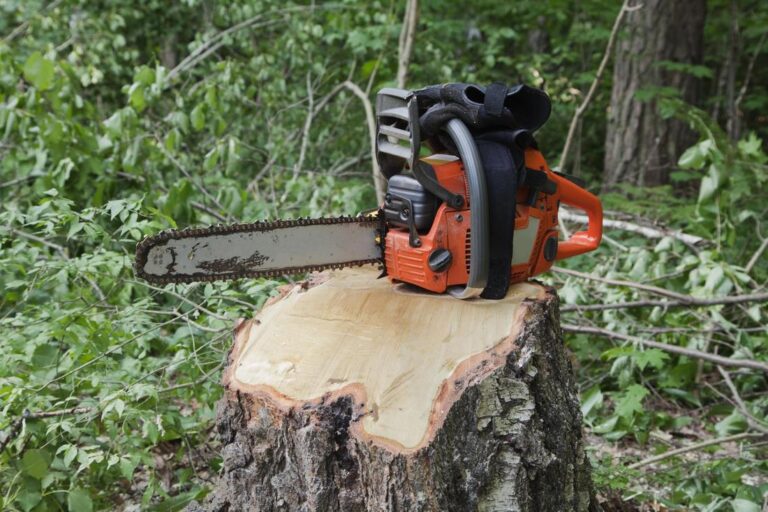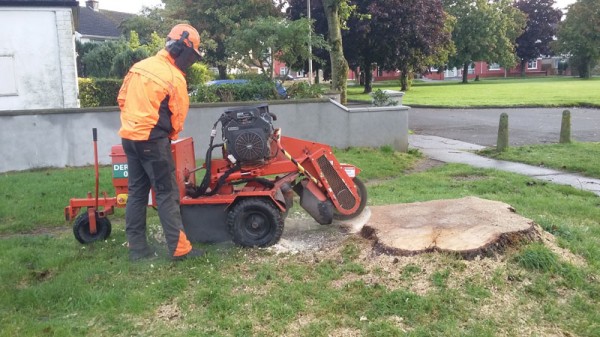Tree Stump Removal: What You Need to Know
Tree stump removal is an essential task for anyone who has trees on their property. Whether you want to clear space for landscaping or prevent pests and diseases, removing tree stumps is a necessary step. In this article, we will discuss the basics of tree stump removal, the tools and equipment involved, safety measures to consider, and the cost implications of hiring professionals or doing it yourself.
Understanding the Basics of Tree Stump Removal
Tree stump removal is not as simple as cutting down a tree. The process involves eliminating the entire stump, including its roots, to prevent regrowth. Leaving the stump behind can lead to issues such as new shoots sprouting or tree diseases spreading to nearby plants.
When a tree is cut down, the remaining stump can be a stubborn reminder of what once stood tall in your yard. It’s essential to address this leftover remnant to ensure the health and aesthetics of your outdoor space. By removing the stump completely, you create a clean slate for potential landscaping projects or new plantings.
Why Tree Stump Removal is Necessary
There are several reasons why tree stump removal is necessary. First, tree stumps can be unsightly and may detract from the overall appearance of your yard or garden. Second, they can pose a tripping hazard, especially if they are not easily visible. Finally, untreated stumps can attract pests like termites or beetles, which can then infest other trees on your property.
Furthermore, decaying tree stumps can become a breeding ground for fungi and bacteria, potentially compromising the health of other plants in the vicinity. By eliminating the stump, you reduce the risk of disease spreading and promote a healthier environment for your garden to thrive.
The Process of Tree Stump Removal
There are several methods for tree stump removal, including stump grinding, chemical removal, and manual extraction. Stump grinding involves the use of a specialized grinding machine to break the stump and roots into small wood chips. Chemical removal entails using stump killers or substances that accelerate the decomposition process. Manual extraction requires digging around the stump and cutting away the roots before pulling out the stump.
Each method of stump removal has its own set of advantages and considerations. Stump grinding is often preferred for its efficiency and ability to quickly turn the stump into mulch, which can be used as a natural fertilizer. Chemical removal, while effective, may take longer to fully eradicate the stump. Manual extraction, though labor-intensive, provides a hands-on approach to ensure the entire stump and roots are removed from the ground. Learn more about the importance of stump grinding for your yard.
Tools and Equipment for Tree Stump Removal
The process of tree stump removal can be a challenging task, requiring the right tools and equipment to ensure a successful outcome. The type of tools needed for this job will vary depending on the method you choose to employ. Whether you decide to hire professional services or take on the project yourself, having the appropriate tools is essential for a smooth and efficient removal process.
Professional tree stump removal services often come equipped with a range of heavy-duty machinery designed specifically for this purpose. One of the most common tools used by professionals is a stump grinder, a powerful machine that can quickly and effectively grind stumps and their roots. In addition to stump grinders, professionals may also utilize chainsaws, axes, and shovels for manual extraction when necessary. These tools, combined with the expertise of trained professionals, ensure that the stump removal process is completed safely and efficiently.
Professional Tree Stump Removal Tools
When enlisting the help of professional tree stump removal services, you can expect the use of specialized equipment that is not typically found in a homeowner’s toolkit. Stump grinders, in particular, are a staple tool in the arsenal of professional stump removers. These heavy-duty machines feature rotating cutting discs that can reduce a stump to mulch in a matter of minutes, making them highly efficient for large or stubborn stumps. Additionally, professionals may use chainsaws to cut the stump closer to the ground, axes for splitting stubborn roots, and shovels for clearing away debris.
DIY Tree Stump Removal Tools
If you are considering tackling tree stump removal on your own, it is important to have the right tools for the job. While professional-grade equipment may not be necessary for smaller stumps, having a few key tools can make the process more manageable. A chainsaw or handsaw is essential for cutting through the bulk of the stump, while a mattock or pickaxe can help loosen the soil around the roots. An ax is useful for severing thick roots, and a sturdy shovel is necessary for digging out the loosened soil and debris. By having these tools on hand and taking the time to plan your approach, DIY tree stump removal can be a rewarding and cost-effective project.
Safety Measures in Tree Stump Removal
While tree stump removal can be a rewarding task, it is essential to prioritize safety to prevent accidents or injuries. Here are some safety measures to consider:
Personal Protective Equipment (PPE)
Wearing the appropriate personal protective equipment is crucial during tree stump removal. This may include safety glasses or goggles, gloves, a helmet, and sturdy work boots. PPE helps protect against flying wood chips, sharp objects, and potential falls.
It’s also important to consider the clothing you wear during tree stump removal. Avoid loose clothing that could get caught in machinery or tools. Option for fitted clothing that allows for easy movement and doesn’t pose a safety hazard. Long pants and long sleeves can provide an additional layer of protection against scratches and cuts from branches or rough tree bark.
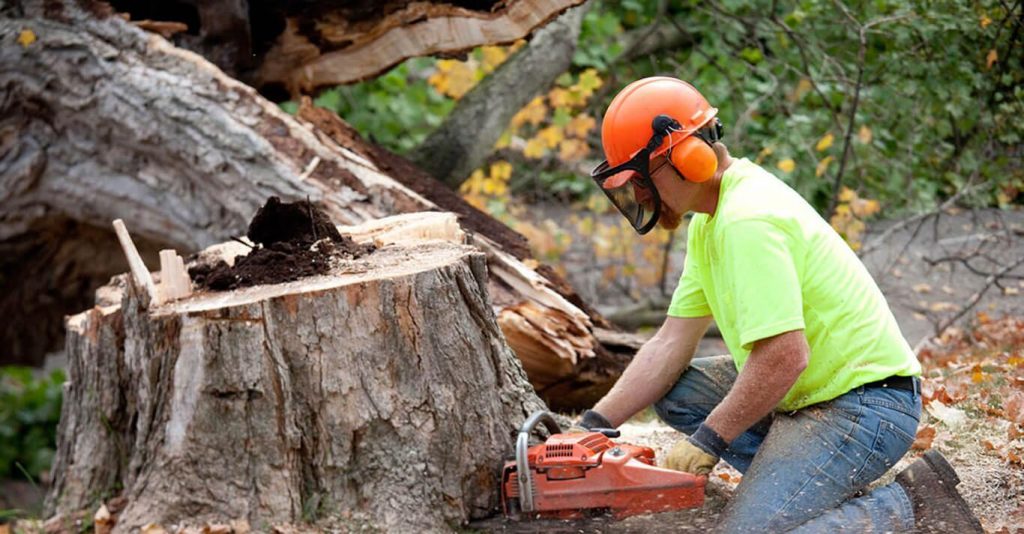
Safe Operation of Tree Stump Removal Tools
Whether you are using manual tools or heavy machinery, it is vital to follow proper operating procedures. Carefully read the manufacturer’s instructions, maintain a firm grip on the tools, and ensure that bystanders are at a safe distance. Additionally, always work in well-ventilated areas and be cautious of underground utilities.
Before starting the tree stump removal process, inspect all tools and equipment for any damage or defects. Ensure that blades are sharp and properly secured, and that machinery is in good working condition. Regular maintenance and inspections can help prevent accidents caused by faulty equipment.
Hiring a Professional vs. DIY Tree Stump Removal
Deciding whether to hire a professional or attempt DIY tree stump removal depends on various factors. Consider the following:
When it comes to tree stump removal, there are a few factors to consider before making a decision. One of the key factors is the size and number of stumps you need to remove. If you have multiple large stumps or hard-to-remove varieties, professionals can handle the job more efficiently. They have the necessary equipment and expertise to tackle even the most challenging stumps.
Another important factor to consider is the amount of time and effort you are willing to invest in the stump removal process. Removing stumps requires physical labor and a significant time commitment. Hiring professionals saves you both time and effort, allowing you to focus on other important tasks or simply enjoy your free time.
Safety concerns are also a crucial consideration. Stump removal can be dangerous, especially if you lack experience with power tools or manual techniques. Professionals have the necessary expertise to carry out the task safely, minimizing the risk of accidents or injuries. They are trained to handle the equipment properly and take all necessary precautions to ensure a safe working environment.
Steps for DIY Tree Stump Removal
If you decide to remove tree stumps yourself, here are some basic steps to follow:
The first step in DIY tree stump removal is to assess the stump. Determine the size, condition, and depth of the stump to choose the appropriate removal method. This will help you determine whether you need to rent a stump grinder, use chemical removal products, or opt for manual extraction methods.
Once you have assessed the stump, gather the necessary tools and equipment required for the chosen removal method. This may include a chainsaw, shovel, pickaxe, or stump grinder. Make sure you have all the tools you need before you begin the removal process to avoid any unnecessary delays.
Before you start working on the stump, it’s important to clear the area around it. Remove any rocks, debris, or vegetation to provide enough room for the removal process. This will make it easier to maneuver the tools and ensure a smoother and more efficient removal process.
Now that you have assessed the stump, gathered the necessary tools, and cleared the area, it’s time to follow the chosen removal method. Whether you opt for grinding, chemical removal, or manual extraction, carefully follow the instructions for each method. Take your time and work methodically to ensure the best possible results.
Once the stump is successfully removed, you will need to determine the best way to dispose of it. You can either hire a removal service to take care of it for you or repurpose the wood for other uses. Consider recycling the wood or using it for firewood, mulch, or even DIY projects.
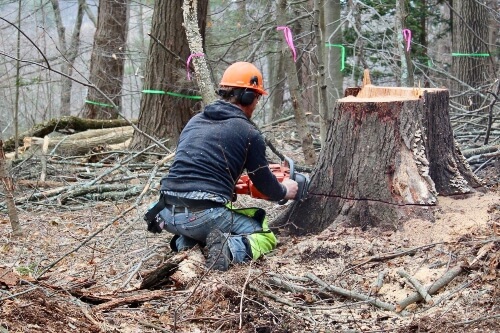
Cost Implications of Tree Stump Removal
The cost of tree stump removal can vary depending on several factors, including the method chosen, the size and number of stumps, accessibility, and local market rates. Here are two approaches to consider:
Estimating the Cost of Professional Services
When hiring professionals, they typically charge based on the size, location, and difficulty of the job. On average, you can expect to pay between $100 and $400 per stump. However, it is always best to get quotes from multiple companies to ensure you are getting a fair price.
Calculating the Cost of DIY Tree Stump Removal
If you opt for DIY stump removal, the cost will primarily comprise the tools and equipment you need to purchase or rent. Additionally, you may need to consider the disposal costs if you hire a service to remove the debris. Keep in mind that DIY stump removal requires time, physical effort, and some level of expertise.
Tree stump removal is a significant task that requires careful consideration. By understanding the basics, having the right tools and equipment, practicing safety measures, and evaluating the cost implications, you can make an informed decision on whether to hire professionals or tackle the job yourself.
Another factor to keep in mind when considering tree stump removal is the type of tree that was originally present. Some tree species have deeper and more extensive root systems, making stump removal more challenging and potentially more expensive. For example, oak trees are known for their deep roots, which can extend far beyond the tree’s canopy. Removing an oak tree stump may require specialized equipment and expertise, adding to the overall cost.
Furthermore, the location of the tree stump within your property can impact the cost of removal. Stumps located near buildings, fences, or underground utilities may require extra care and precision to avoid causing damage during the removal process. In such cases, professionals may need to use alternative methods or tools to safely extract the stump, which can result in higher costs compared to stumps in open, easily accessible areas.

